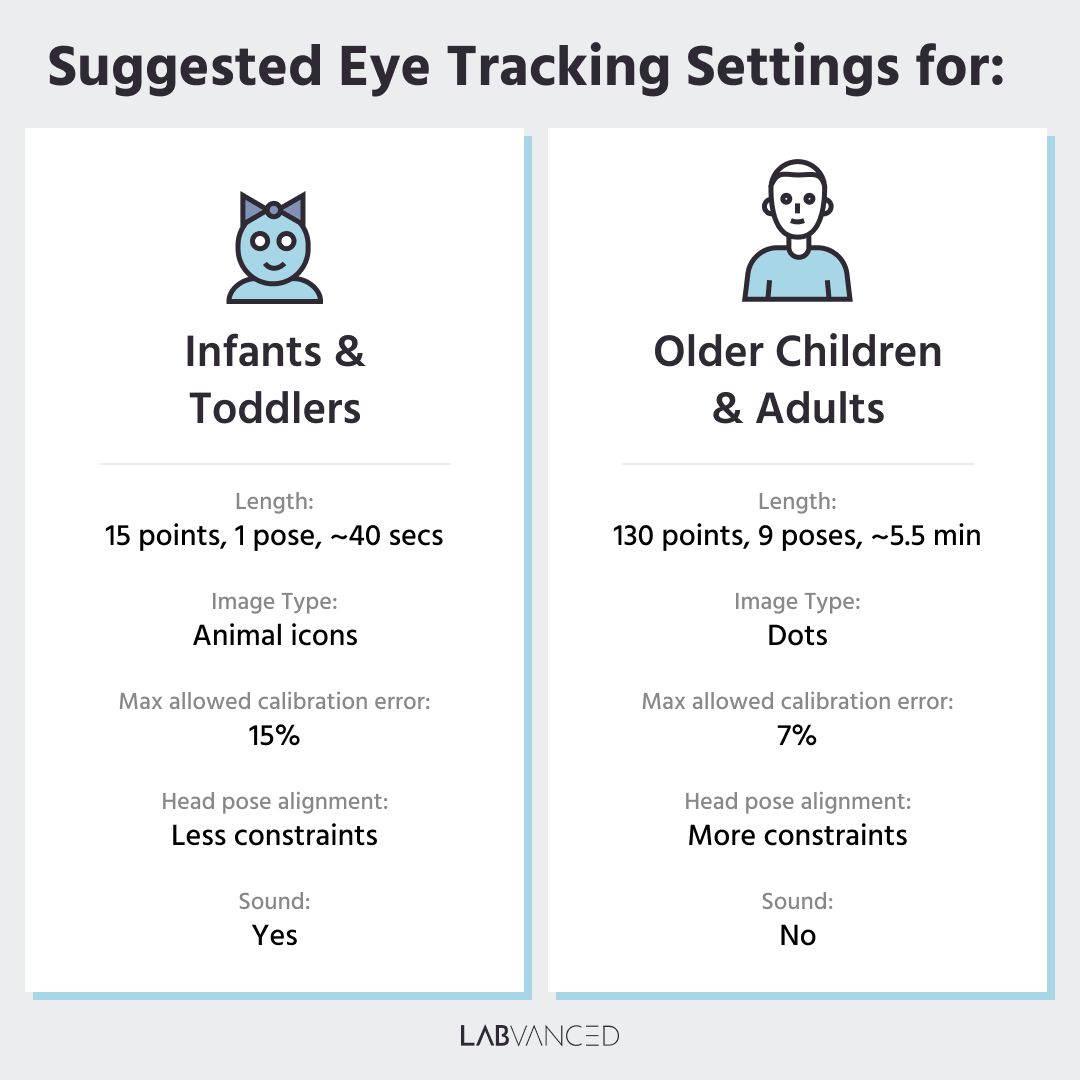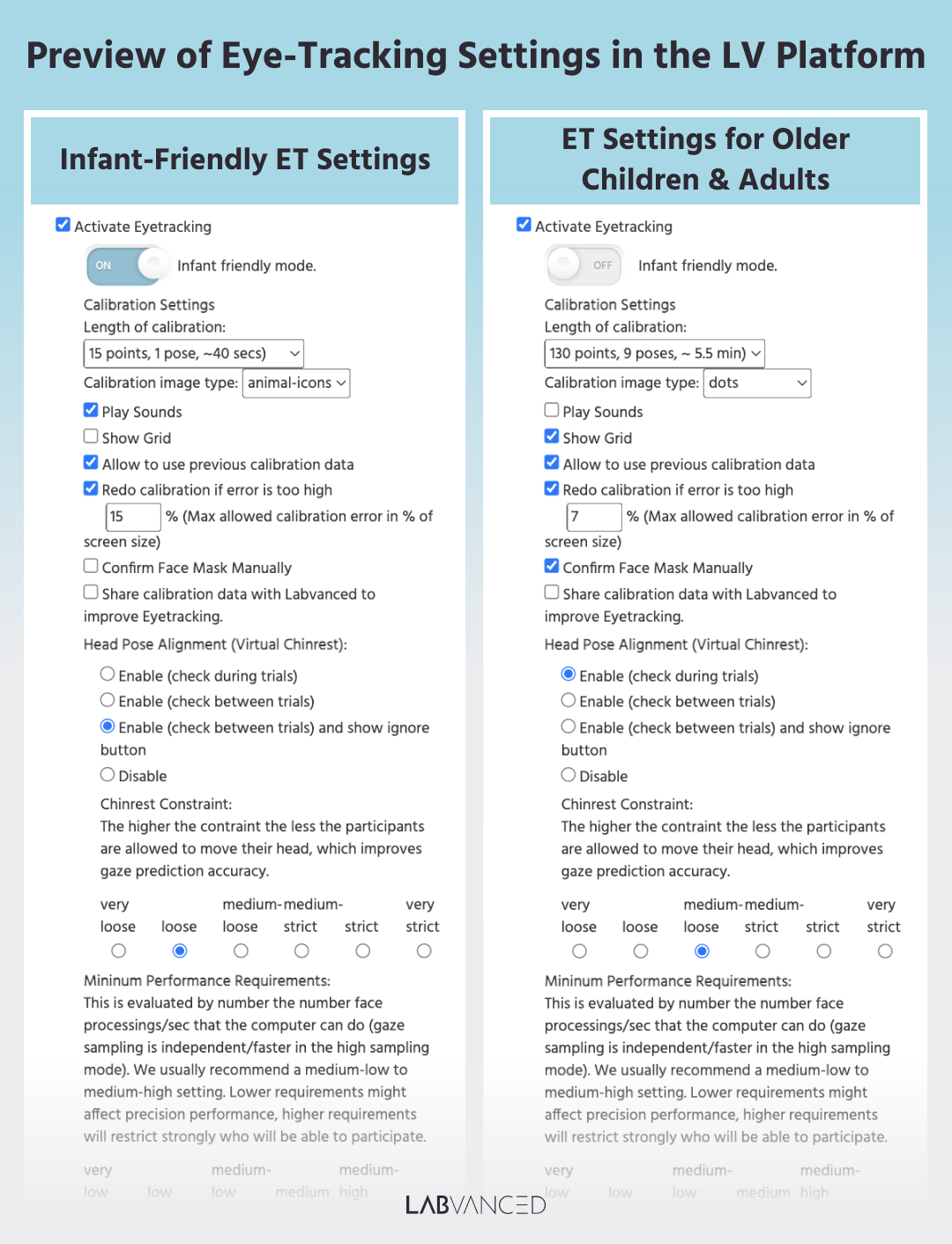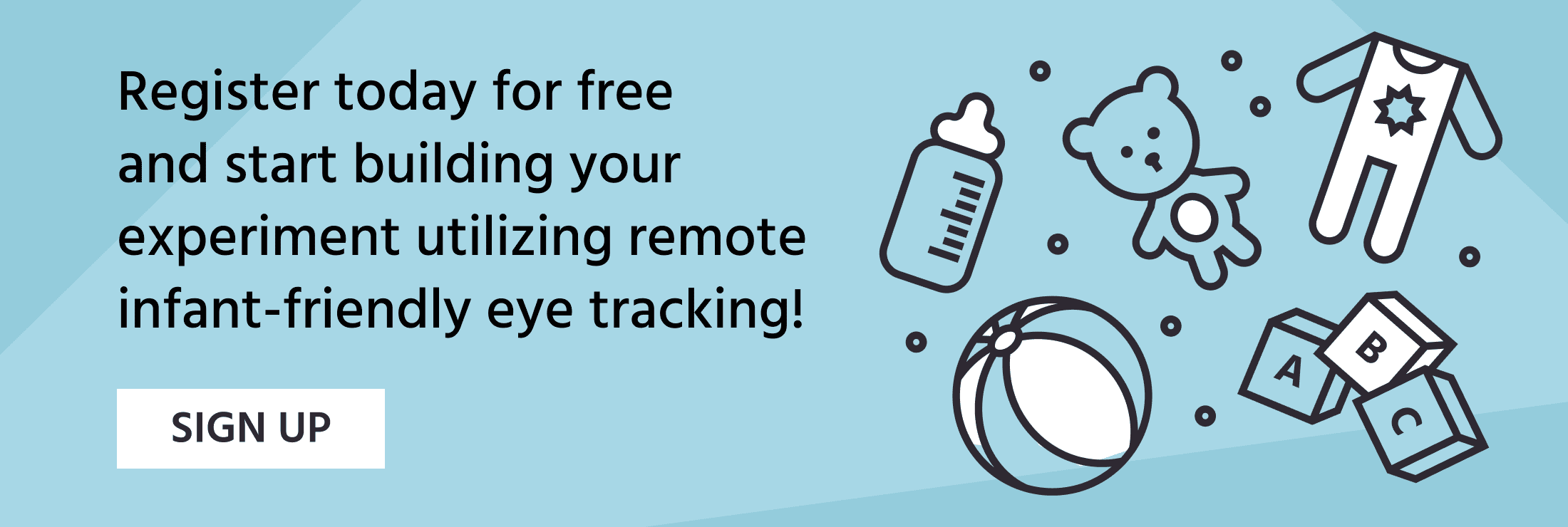
The Power of Remote & Infant-friendly ET
Remote eye tracking is a non-invasive method that relies on the computer’s webcam to measure an infant's visual attention by measuring their eye movements. As infants and toddlers are a sensitive population, making eye tracking to be infant-friendly is very important for research and overall participant experience.
Main Challenges of Working with Infants and Eye Tracking
Here are a few of the biggest challenges that developmental psychologists face when utilizing eye tracking with infants and toddlers:
- Fuzziness: Fuzziness may lead to lower data quality as it is hard to control infants and unrealistic to expect them to be still for 10 mins
- Difficult calibration process: Lengthy calibration processes can be difficult and tiring.
- Lack of engaging stimuli: Fixation points and crosses may be boring for infants and toddlers, thus may not grab their attention.
- High precision: Related to the points above, high precision is required for eye tracking studies to be relevant and trustworthy but acquiring such values is difficult in such a sensitive population.
- Limited sample: Infant studies are by nature limited given that it must be plausible for participants to reach the labs, ie. potential participants must be within traveling distance.
- Low compliance: Due to the demanding nature of infant studies, compliance is a big issue for researchers. This is especially for longitudinal studies that require high commitment and dedication to repeatedly visit the lab.
- Lack of satisfaction / empowerment: Related to the point above, participating in such studies can take a toll on the families who have to program their schedules in order to meet an appointment at the labs (ie. the child may need to take a nap but is expected to go to the lab). Furthermore, not completing the experiment may have a further effect on toddlers who may feel lack of empowerment in their inability to complete a task, ie. they want to be able to finish but cannot.
- Difficult to replicate: Sometimes, because eye tracking equipment is lab-specific and the experiments are not publicly available, it can be challenging to replicate another researcher’s study.
Effective Solutions for Employing ET for Infants
By utilizing webcam-based eye tracking, the challenges described above are addressed by making it more infant-friendly:
- Colorful animals: Instead of the typical fixation cross, colorful animals can be used to get the attention of infants and toddlers. Colorful animals can also be used instead of fixation points calibration. By their very nature, this is more interesting to babies and is more likely to keep them engaged. Further below are images and a video that show how colorful animals are used in Labvanced during the calibration process.
- Exciting sounds: Since infants and toddlers are fascinated by sound and orient themselves towards the source of the sound, adding audio to the experiment or during the calibration is another way to make a study more infant-friendly.
- Virtual chin rest: A virtual chin rest automatically detects when one is not oriented towards the computer screen or has moved too much from an acceptable position, ie. it is the virtual equivalent of a chin rest used in labs during eye tracking experiments. For studies with infants and toddlers in Labvanced, you can adapt the settings (described further below) to be more tolerant of movements (or even disable it entirely).
- Utilize head tracking: For some experiments, using head tracking can be a viable solution. By making two visuals far enough on the screen, head tracking can be used as an approximation because, in the end, the goal is about understanding attentional processes such as through the preferential looking paradigm. In other words, for some studies you might not need high precision but head tracking will suffice.
- Flexibility: Remote studies provide flexibility by allowing participants to start at the time that works best for them and their toddler’s schedule. Instead of planning their whole day around a lab visit and hoping everything goes smoothly, they can just log in to their computers from the comfort of their home and participate immediately in the study without having to get ready and travel. This also makes it easier for families to commit to participating in longitudinal studies.
- Ecological validity: Since infants and toddlers are encaptivated by new environments, visiting a new place like a lab can be an overwhelming and unknown experience to them. By participating in a study from their home, in a familiar environment, the data collected can show higher integrity.
- Larger sample population: As remote studies are not constrained by space in the way that in-lab studies are, participants can be recruited from anywhere in the world, allowing researchers to sample from a wider audience.
- Reproducibility: By utilizing webcam-based eye tracking and online studies in Labvanced, researchers can more easily have their findings reproduced by other scientists in their field.
Using Infant-Friendly Eye Tracking
As shown in the infographic below, there are differences in the recommended eye tracking settings between infants / toddlers and older children / adults. Infant-friendly eye tracking keeps in mind the nature of babies and reflects this in the appropriate settings for that sensitive population. With that in mind, the calibration process and virtual chin rest settings are adjusted in order to be better suited for infants / toddlers. To do this, the calibration length is shortened (less points, poses and time duration), the image type used during the calibration is changed so that animals are presented instead of dots (see further below for more details), also the maximum calibration error can be adjusted and sounds can be added.

In greater detail, the infant-friendly settings as they appear in the Labvanced app can be seen below. On the left, when the blue button for ‘infant friendly mode’ is toggled on, the suggested settings automatically appear but can be further edited. By contrast, on the right, the default eye tracking settings appear.

Infant-friendly Calibration Process
Calibration is an important step of eye tracking. With Labvanced’s webcam-based eye tracking, calibration is the step that trains the eye tracking to be participant-specific. As mentioned previously, the use of infant-friendly eye-tracking calibration can be configured by utilizing the settings specifically tailored for infants. This calibration is designed to captivate infants' attention through engaging animal illustrations and sounds. It is also shorter calibration than for adults. All this to address the unique challenge of studying infants and young children, who often have short attention spans and limited understanding of instructions.
Take a look at the video below which shows the infant-friendly calibration process in action! This is what your participants would see when you have infant-friendly eye tracking settings activated in your Labvanced experiment:
The Future of Infant-Friendly Eye Tracking Research
Remote eye tracking for infants is increasingly becoming more popular in the realm of developmental psychology research due to the promise it holds for reducing costs, increasing efficiency, and reaching a wide range of the population (Rhodes et al., 2020).
Applying remote eye tracking is also gaining traction in the area of clinical psychology. A recent example of this is through the innovation of using gaze patterns to diagnose at-risk infants for developing autism spectrum disorder (ASD) which allows for early-intervention (Jones et al., 2023).
At Labvanced, we are also doing our share to further this methodology and to make it more powerful and adopted by developmental psychologists. We also have ongoing collaboration efforts with several leaders in the space of developmental psychology to further improve this technological capability. For scientific reference, a peer-reviewed paper using Labvanced’s webcam-based eye tracking published by Banki et al. assessed 4-6 month old infants’ abilities to detect audio-visual asynchrony. Since its publication, many features have been added, including accurate timestamp recording, the ability to skip the head position check, and the additional recording of the confidence for gaze points. To try out an experiment in Labvanced with infant-friendly eye tracking and calibration, try out this Preferential Looking Study.
Complementing In-Lab Research with Online Studies
While the possibility of running online studies with infants has been possible for several years, it wasn’t until the coronavirus epidemic that this approach in developmental psychology really took off. Even though some studies must occur in-person at a lab, there is a wide range of studies that can be performed remotely, offering many benefits to researchers and the families who participate in the research. With online studies, researchers can save time from recruiting by sampling from a larger population, observe more natural behavior as the children are in their natural environment, make their studies more transparent and replicable; while families can more easily participate, especially in longitudinal studies. Remote infant-friendly eye tracking is a way to add more depth to online studies by collecting physiological data related to attention processes.
References
Bánki, A., de Eccher, M., Falschlehner, L., Hoehl, S., & Markova, G. (2022). Comparing online webcam-and laboratory-based eye-tracking for the assessment of infants’ audio-visual synchrony perception. Frontiers in Psychology, 12, 733933.
Jones, W., Klaiman, C., Richardson, S., Lambha, M., Reid, M., Hamner, T., ... & Klin, A. (2023). Development and replication of objective measurements of social visual engagement to aid in early diagnosis and assessment of autism. JAMA Network Open, 6(9), e2330145-e2330145.
Rhodes, M., Rizzo, M. T., Foster-Hanson, E., Moty, K., Leshin, R. A., Wang, M., et al. (2020). Advancing developmental science via unmoderated remote research with children. J. Cogn. Dev. 21, 477–493. doi: 10.1080/15248372.2020. 1797751
